The new proposal is just the most recent step in a process that reaches back almost a decade, culminating in the Master Plan (2015), the Housing Production Plan (2016) and the mixed-using zoning amendments of 2016. The Town has consistently proposed smart growth: more development along Arlington’s transit corridors to increase the tax base, stimulate local commerce, and provide more varied housing opportunities for everyone, including low and moderate income Arlingtonians. This year’s proposals are no head-long rush into change. Today’s debate is similar to the debate before Town Meeting three years ago. If anything, progress has been frustratingly slow. To realize the Master Plan’s vision of a vibrant Arlington with diverse housing types for a diverse population, we must stay the course on which we have been embarked for so long.
Related articles
Accessory Dwelling Units (aka “granny flats”)
The following information was presented to the Arlington Redevelopment Board in October, 2020 by Barbara Thornton, TMM, Precinct 16
This Article proposes to allow Accessory Dwelling Units, “as of right”, in each of the 8 residential zoning districts in Arlington.
Why is this zoning legislation important?
Arlington is increasingly losing the diversity it once had. It has become increasingly difficult for residents who have grown up and grown old in the town to remain here. This will only become more difficult as the effects of tax increases to support the new schools, including the high school, roll into the tax bills for lower income residents and senior citizens on a fixed income. For young adults raised in Arlington, the price of a home to buy or to rent is increasingly out of reach.
Who benefits from ADUs?
- Families benefit from greater flexibility as their needs change over time and, in particular providing options for older adults to be able to stay in their homes and for households with disabled persons or young adults who want additional privacy but still be within a family setting.
- Residents seeking an increase in the diversity of housing choices in the Town while respecting the residential character and scale of existing neighborhoods; ADUs provide a non-subsidized form of housing that is generally less costly and more affordable than similar units in multifamily buildings;
- Residents wanting more housing units in Arlington’s total housing stock with minimal adverse effects on Arlington’s neighborhoods.
What authority and established policy is this built on?
Arlington’s Master Plan is the foundational document establishing the validity and mission for pursuing the zoning change that will allow Accessory Dwelling Units.
Under Introduction in Part 5, Housing and Residential Development, the Master Plan states: Arlington’s Master Plan provides a framework for addressing key issues such as affordability, transit-oriented residential development, and aging in place.
The Master Plan states that the American Community Survey (ACS) reports that Arlington’s housing units are slightly larger than those in other inner-suburbs and small cities. In Arlington, the median number of rooms per unit is 5.7. There is a great deal of difference in density and housing size among the different Arlington neighborhoods. The generally larger size of homes makes it easier to contemplate a successful move to encourage ADUs.
What do other municipalities do?
According to a study (https://equitable-arlington.org/2020/02/16/accessory-dwelling-units-policies/), by 2017 65 out of 101 municipalities in the greater Boston (MAPC) region allowed Accessory Dwelling Units by right or by special permit. The average number of ADU’s added per year was only about 3. But by 2017, Lexington had 75 ADUs and Newton had 73. Both of these communities were among about 10 “as of right” municipalities in the MAPC region. This finding suggests that communities with more restrictions are less likely to see any significant affordable housing benefits.
Even in the midst of a housing crisis in this region, according to Amy Dain, housing expert, (https://equitable-arlington.org/2020/02/18/zoning-for-accessory-dwelling-units/) most municipalities still have zoning laws that restrict single family home owners from creating more affordable housing.
And this is despite the fact that, as according to Banker & Tradesman, March 10, 2020: https://www.bankerandtradesman.com/63-percent-in-greater-boston-back-adus/, 63% of people in the region approve of ADUs. California has recently passed strong pro-ADU legislation. A study by Zillow further corroborated this strong interest in communities across the US, including our region. https://equitable-arlington.org/2020/03/10/adu-popularity/.
Learn more about Accessory Dwelling Units/ “Granny Flats” here: https://planning.org/knowledgebase/accessorydwellings/
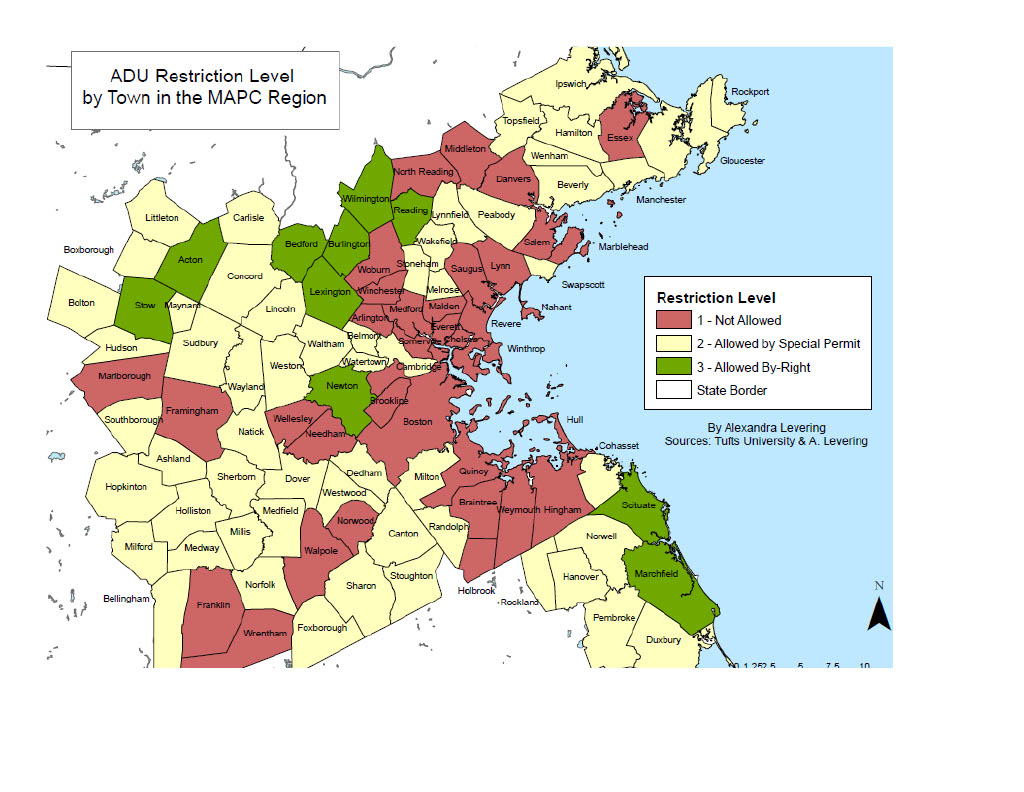
This is the second in a series of “Arlington 2020” articles. The first article looked at the number of one-, two-, and three-family homes and condominiums in Arlington, and how that housing stock has changed over time. This article will examine changes in the value of those properties. We’re going to look at “value” through the lens of property assessments, so we should start with an explanation of what property assessments are and how they’re used.
A property assessment is simply the Town Assessor’s best estimate of what a property is worth, based on market values. The assessor’s office inspects properties every ten years; during intervening years, assessments are adjusted based on sale prices of similar homes in a given tax neighborhood. For all practical purposes, assessed values tend to trail market values by two years. In my neighborhood, property assessments are spot on — my house was assessed at $501,000 in 2020; during 2018, sales of similar homes in the neighborhood ranged from $495,000 to $520,000.
Condominiums have a single assessed value, which includes land and buildings. Otherwise, assessed values are broken down into land value, building value, and yard items (e.g., a garage or a shed).
Assessed values are used to determine the tax rate. The assessors page on the town website has calculations in worksheet form, but for all practical purposes, it’s just a division problem. One takes the total tax levy and divides by the sum of all property assessments (in thousands of dollars), and that’s the tax rate. An individual’s taxes are the assessed value of their property (in thousands of dollars) multiplied by the tax rate. If an individual owns (say) 1% of the assessed value in town, that individual will pay 1% of the property tax levy.
The main point is that assessed values are based on market values, but with a two-year lag. Consequently, we can use them as a way to see how home prices have changed over time.
With that background information out of the way, we can look at some numbers. Here’s a graph of the median assessed values for condominiums, one-family, two-family, and three-family homes from 2013 through 2020. (the “median” is a value such that half of the assessments are above, and half are below).
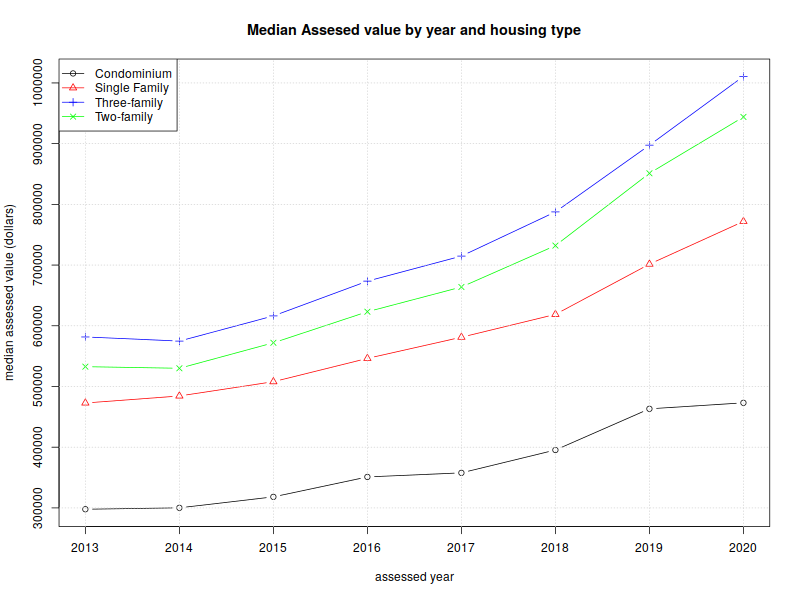
| year | Condominium | Single Family | Two-family | Three-family |
| 2013 | $297,800 | $472,850 | $532,650 | $581,600 |
| 2014 | $300,150 | $484,400 | $530,000 | $574,800 |
| 2015 | $318,200 | $507,900 | $572,000 | $616,300 |
| 2016 | $351,050 | $546,300 | $623,150 | $673,550 |
| 2017 | $357,750 | $581,200 | $663,900 | $714,800 |
| 2018 | $395,400 | $618,800 | $732,100 | $787,600 |
| 2019 | $463,250 | $701,550 | $851,200 | $897,500 |
| 2020 | $473,100 | $771,900 | $944,000 | $1,010,850 |
| %change | 58.87% | 63.24% | 77.23% | 73.81% |
As one would expect, two-family homes are worth more than single-family, and three-family are worth more than two. Condominiums have a lot of variety; they could be half of a duplex, or a single unit in an apartment building. But a general upward trend is clearly evident.
These values are straight out of the assessor’s database, and not adjusted for inflation. The Bureau of Labor Statistic’s inflation calculator shows 12% inflation between 2013 and 2020; the %change is pretty considerable, even if one deducts 12% for inflation.
Next, I’d like to dig further into the 1–3 family assessments, by breaking them down into the value of land vs the value of buildings, and showing how that’s changed over time.
Single-family homes:

| year | Land value | Building value | Total assessed value |
| 2013 | $243,700 | $226,300 | $472,850 |
| 2014 | $253,750 | $227,050 | $484,450 |
| 2015 | $272,700 | $229,900 | $507,900 |
| 2016 | $296,400 | $243,950 | $546,400 |
| 2017 | $326,400 | $246,400 | $581,250 |
| 2018 | $360,900 | $248,100 | $618,800 |
| 2019 | $440,400 | $250,400 | $701,600 |
| 2020 | $448,600 | $316,300 | $771,900 |
| %change | 84.08% | 39.77% | 63.24% |
Two-family homes:
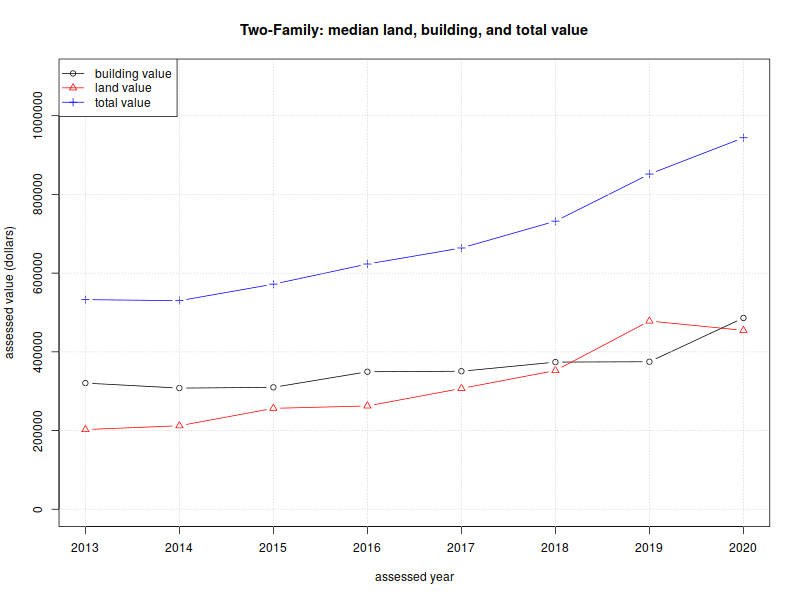
| year | Land value | Building value | Total assessed value |
| 2013 | $202,500 | $320,550 | $532,650 |
| 2014 | $212,250 | $307,800 | $530,000 |
| 2015 | $256,400 | $309,800 | $572,000 |
| 2016 | $262,500 | $349,400 | $623,150 |
| 2017 | $307,000 | $350,700 | $663,900 |
| 2018 | $352,500 | $373,900 | $732,100 |
| 2019 | $478,300 | $374,850 | $851,700 |
| 2020 | $454,500 | $486,100 | $944,000 |
| %change | 124.44% | 51.65% | 77.23% |
Three-family homes:
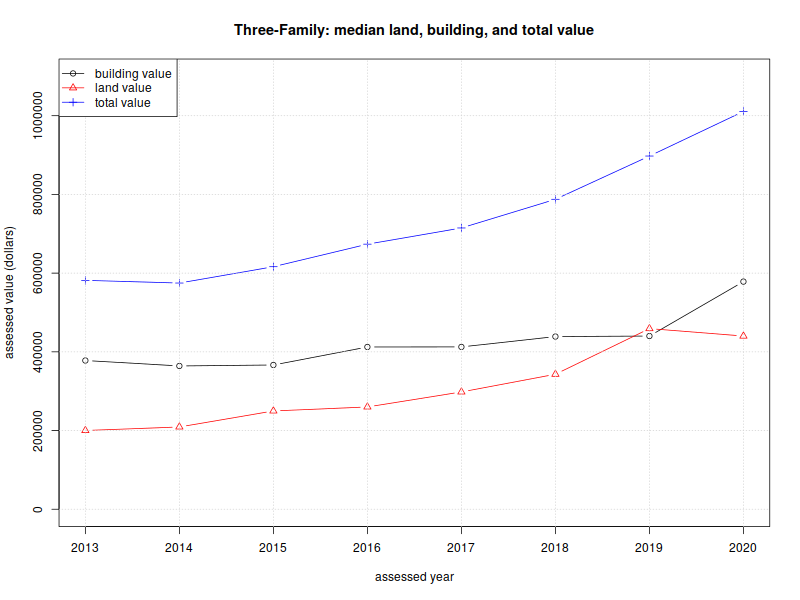
| year | Land value | Building value | Total assessed value |
| 2013 | $200,100 | $377,900 | $581,600 |
| 2014 | $209,100 | $364,100 | $574,800 |
| 2015 | $249,800 | $366,550 | $616,300 |
| 2016 | $259,950 | $412,350 | $673,550 |
| 2017 | $298,100 | $412,500 | $714,800 |
| 2018 | $343,050 | $438,800 | $787,600 |
| 2019 | $459,000 | $440,100 | $897,500 |
| 2020 | $440,100 | $578,450 | $1,010,850 |
| %change | 119.94% | 53.07% | 73.81% |
There are several things worth pointing out in these breakdowns.
First, note that the land and building values “jump” a bit between 2019–2020. 2020 was one of our full reassessment years, so I’m willing to attribute this to a periodic course correction. The total increase is generally linear, but the land/building composition has changed.
Second, the median land value for single-family homes is higher than the median building value, for all years between 2013–2020.
Third, most of the increases come from changes in land value. I believe this comes down to location, location, and location. Arlington has a well-respected public school system, and it’s close to universities and tech centers is Cambridge and Boston, and office parks in Lexington, Waltham, and Burlington. City amenities are close at hand.
So what does one do about our rising home prices, and in particular, the rising value of land? The first (and perhaps default) answer is to do nothing. Rising property values are a boon to homeowners who purchased a capital asset (i.e., a house) in the past, and have seen its value appreciate over time. The downside of doing nothing is that each year, increasing housing prices create an ever-increasing income threshold for new residents.
An alternative approach would be to allow more (and smaller) units to be built on each lot. This requires reconstruction or redevelopment, but it allows the cost of land to be amortized among several households. More units/lot means more people and more density, but it reduces the income threshold for buying in to Arlington. (Note that the per-unit cost for three-family homes is lower than the per-unit cost for two-family homes. Similarly, the per-unit cost for two-family homes is lower than the cost of a single-family home).
A third article will look at the distribution of housing prices in Arlington, and how the distribution varies by housing type.
Here is a spreadsheet of data shown in this post.
The presentation, dated March 11, 2019, includes slides used to present the information necessary to understand the rationale for zoning changes, the location of the zoning areas under consideration and the charts, tables and maps that help describe the situation. The proposed zoning changes, especially articles 6, 7, 8, 11 and 16, only cover changes affecting about 7% of the Town, those parts of the Town that are currently zoned R4-R7 and the B zoning districts.
State Representatives Dave Rogers (Arlington, Belmont and Cambridge) and Sean Garballey (Arlington, Medford) have sent a letter to Town Meeting Members backing the MBTA Communities Plan. They write:
We believe the plan in front of Town Meeting provides a meaningful framework to address the housing shortage in Arlington.
To read the full letter, click here for PDF.

In a 2019 study, MAPC found that:
- Three out of ten spaces sit empty during peak demand
- The key factors that drive parking demand are parking supply, transit accessibility and the percentage of deed-restricted units
This study raises important questions about the wisdom of continuing to commit large sections of the land area of our municipalities to be on reserve for parking cars. Such extra space could be used to benefit the open space, environmental sustainability and the need for more housing.
I’ve had an annual ritual for the past several years: obtain a spreadsheet of property assessments from the Town Assessor, load them in to a database, and run a series of R computations against the data. I started doing this for a number of reasons: to understand what was built where (our zoning laws have changed over time, and there are numerous non-conforming uses), the relationship between land and building values, the capital costs of different types of housing, and how these factors have changed over time.
I’d typically compile these analyses into a fact-book of sorts, and email it around to people that I thought might be interested. This year, I’m going to post the analyses here as a series of articles. This first installment contains basic information about Arlington’s low-density housing: single-, two-, and three-family homes, as well as condominiums. Condominiums are something of an oddball in this category — a condominium can be half of a two-family structure, part of a larger residential building, or somewhere in between. There’s a lot of variety.
Here’s a table showing how the number of units has changed over time, since 2013.
| land use | 2013 | 2014 | 2015 | 2016 | 2017 | 2018 | 2019 | 2020 |
|---|---|---|---|---|---|---|---|---|
| Single Family | 7984 | 7983 | 7991 | 8000 | 7994 | 7994 | 7998 | 7999 |
| Condominium | 3242 | 3304 | 3367 | 3492 | 3552 | 3662 | 3726 | 3827 |
| Two-family | 2352 | 2332 | 2308 | 2282 | 2263 | 2218 | 2183 | 2139 |
| Three-family | 207 | 201 | 196 | 194 | 193 | 190 | 185 | 182 |
Arlington’s predominant form of housing — the single family home — has stayed relatively static; we’ve added 15 over the last seven years. The number of condominiums has increased significantly: +585 over seven years. That, coupled with the reduction of two-family homes (-213) and three-family homes (-25) leads me to believe that a fair number of rental units have been removed from the market.
Next, I’d like to look at how these homes are spread across our various zoning districts. (The “Notes” section at the bottom of the post explains what the zoning district codes mean).
| Zone | Single-Family | Condo | Two-family | Three-family |
|---|---|---|---|---|
| B1 | 8 | 22 | 13 | 11 |
| B2 | 1 | 4 | 1 | |
| B2A | 1 | 18 | ||
| B3 | 59 | 4 | ||
| B4 | 1 | 59 | 5 | 5 |
| B5 | 1 | 1 | ||
| I | 8 | 18 | 7 | 1 |
| R0 | 502 | |||
| R1 | 6798 | 168 | 200 | 7 |
| R2 | 647 | 1816 | 1881 | 124 |
| R3 | 4 | 39 | 11 | 17 |
| R4 | 23 | 79 | 2 | 3 |
| R5 | 3 | 616 | 5 | 4 |
| R6 | 2 | 686 | 8 | 7 |
| R7 | 1 | 243 | 2 | 1 |
A few points to note:
- R0 is our newest district, which was established in 1991. It consists only of conforming single-family homes.
- R1 is Arlington’s original (per 1975 zoning) single-family district. It’s predominantly single-family homes, but there are a fair number of two-family homes, and even a few three-families. The presence of condominiums suggests additional multi-family homes (that consist of two or more condominiums)
- R2 is predominantly two-, and three-family homes. Although three-family homes are no longer allowed in this district, R2 has the largest number of three-families in town.
- Residential uses are no longer allowed in the industrial (I) districts, but the I districts contain 34 homes. These buildings pre-date the current zoning laws (aka “pre-existing non-conforming”). A good portion of the Dudley street industrial district is a residential neighborhood.
I’m pointing out these conformities (and non-conformities) for a reason. The zoning map (and use tables) dictate what is allowed today, along with specifying a vision for the future. Our zoning bylaw happens to contain a strong statement to this effect: “It is the purpose of this Bylaw to discourage the perpetuity of nonconforming uses and structures whenever possible” (section 8.1.1(A)). Despite the strong statement of intent, it can take decades (if not generations) for a built environment to catch up with the bylaw’s prescriptions.
I’ll finish this post with a breakdown of how condominiums are distributed across the various zoning districts:
| Zone | 2013 | 2014 | 2015 | 2016 | 2017 | 2018 | 2019 | 2020 | delta |
|---|---|---|---|---|---|---|---|---|---|
| (N/A) | 14 | 15 | 0 | 0 | 0 | 0 | 0 | 0 | -14 |
| B1 | 16 | 16 | 18 | 18 | 18 | 22 | 22 | 22 | 6 |
| B2 | 2 | 2 | 2 | 2 | 4 | 4 | 4 | 4 | 2 |
| B2A | 19 | 18 | 18 | 18 | 18 | 18 | 18 | 18 | -1 |
| B3 | 55 | 55 | 61 | 59 | 59 | 59 | 59 | 59 | 4 |
| B4 | 47 | 47 | 59 | 59 | 59 | 59 | 59 | 59 | 12 |
| I | 18 | 18 | 18 | 18 | 18 | 18 | 18 | 18 | 0 |
| R1 | 140 | 144 | 146 | 148 | 150 | 154 | 162 | 168 | 28 |
| R2 | 1355 | 1406 | 1456 | 1518 | 1574 | 1670 | 1723 | 1816 | 461 |
| R3 | 22 | 25 | 28 | 31 | 31 | 37 | 37 | 39 | 17 |
| R4 | 65 | 67 | 67 | 79 | 79 | 79 | 79 | 79 | 14 |
| R5 | 616 | 616 | 616 | 616 | 616 | 616 | 616 | 616 | 0 |
| R6 | 630 | 632 | 635 | 683 | 683 | 683 | 686 | 686 | 56 |
| R7 | 243 | 243 | 243 | 243 | 243 | 243 | 243 | 243 | 0 |
The last column (“delta”) shows the difference between 2013 and 2020. The largest increase occurred in the R2 (two-family) district, followed by R6 (medium-density apartments, where most of the increase took place in 2014) and R1 (single-family).
That it will do it for the first installation. In the next post, we’ll look at how the cost (assessed values, actually) of Arlington’s low density housing has changed over the last seven years.
Here is a spreadsheet, containing the various tables shown in this article.
Notes
Arlington’s zoning map divides the town into a set of districts, and each district has regulations about what kinds of buildings and uses are allowed (or not allowed). The districts mentioned in this article are:
- B1 (Neighborhood Office district)
- B2 (Neighborhood Business distrct)
- B2A (Major Business District)
- B3 (Village Business District)
- B4 (Vehicular-Oriented Business District)
- I (Industrial District)
- R0 (Single-Family, large-lot district)
- R1 (Single-Family Distict)
- R2 (Two-Family District)
- R3 (Three-Family District)
- R4 (Townhouse District)
- R5 (Low-Density Apartment District)
- R6 (Medium-Density Apartment District)
- R7 (High-Density Apartment District)
Arlington’s Zoning Bylaw describes each district in detail (see sections 5.4.2, 5.5.2, and 5.6.2)
The discussions on zoning have been confusing because while zoning covers ALL of Arlington’s land and the zoning bylaws for all Arlington’s zones are referenced, the key issues of greatest interest to Town Meeting are the discussions about increasing density. These discussions pertain ONLY to those properties currently zoned as R4-R7 and the B (Business) districts. These density related changes would affect only about 7% of Arlington’s land area. The map shows the specific zones that would potentially be affected. They lay along major transportation corridors.
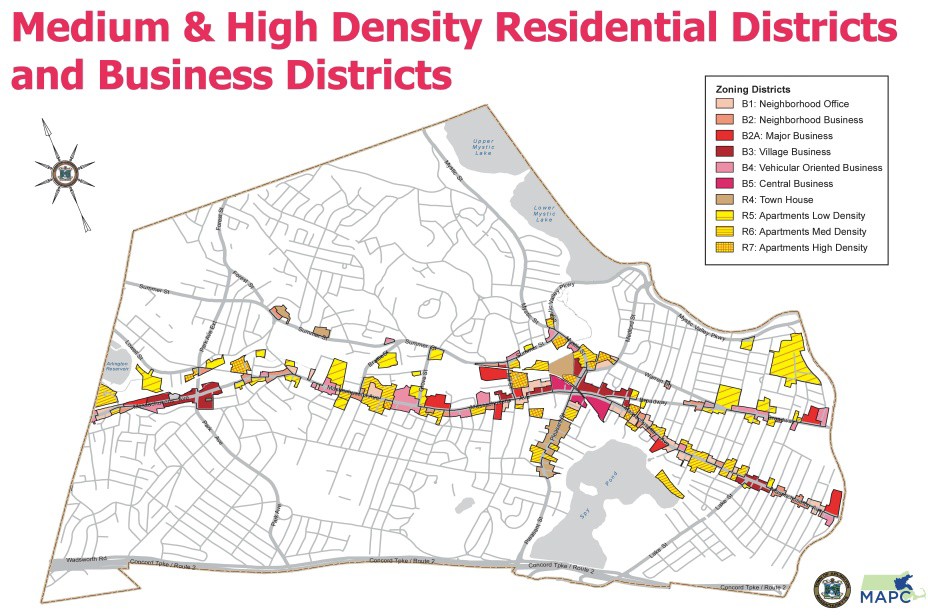
Data in a Mass Housing Partnership report shows how far behind the Boston metropolitan area has fallen in meeting the housing needs of its citizens. There are four primary categories for measuring the inadequacies: 1. Availability, 2. Affordability, 3. L0cation and Mobility and 4. Equitability. See the full report for more data and examples. Two slides are shown below.

